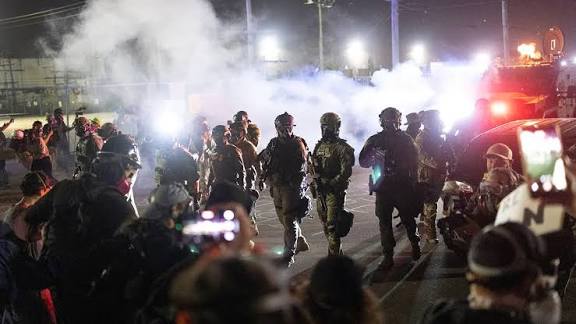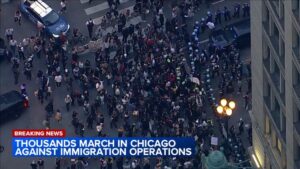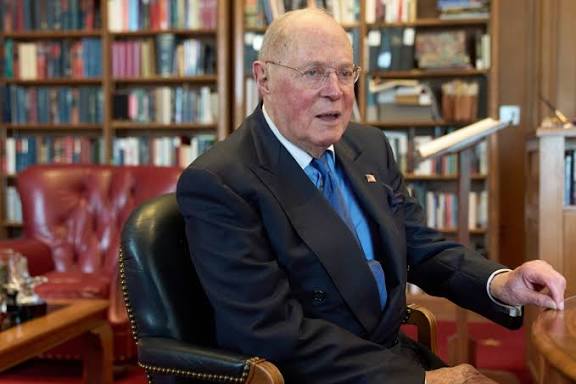Violent anti ICE riots attack: near Chicago,15 arrests,Death,Protests

At least 15 people were arrested outside an Immigration and Customs Enforcement (ICE) processing facility on Saturday. Today we will discuss about Violent anti ICE riots attack: near Chicago,15 arrests,Death,Protests
Violent anti ICE riots attack: near Chicago,15 arrests,Death,Protests
In a series of violent protests near Chicago, a clash between activists and law enforcement escalated into an attack on U.S. Immigration and Customs Enforcement (ICE) facilities, resulting in 15 arrests and at least one death. The incident has brought renewed attention to the ongoing debates over immigration policy, federal enforcement actions, and the growing tensions surrounding ICE and its role in the United States.
These protests, which began peacefully, quickly turned violent as demonstrators rallied against what they described as the inhumane treatment of undocumented immigrants and the controversial practices of ICE. While protests against ICE are not new, this particular incident has sparked widespread outrage and calls for reform, as well as questions about the safety of both protesters and law enforcement officers involved.
Background: The Role of ICE in Immigration Enforcement

The U.S. Immigration and Customs Enforcement (ICE) agency, created in 2003 as part of the Department of Homeland Security, is responsible for enforcing immigration laws, investigating criminal activities related to immigration, and carrying out deportations. Over the years, ICE has become one of the most controversial federal agencies in the U.S., with many critics arguing that its tactics and operations are overly aggressive, inhumane, and often target vulnerable populations, including children and families.
Supporters of ICE, on the other hand, argue that the agency’s mission is essential for national security, public safety, and the integrity of U.S. immigration laws. The debate surrounding ICE has become particularly heated during the past two presidential administrations, with significant political polarization over how the agency should operate and the role it plays in shaping the future of immigration policy in the country.
The Build-Up to the Protests
Tensions between ICE and immigrant rights activists have reached a boiling point in recent years, as the agency’s role has been heavily scrutinized. The protests near Chicago, though not isolated, were part of a broader, nationwide pushback against ICE’s actions, particularly under the Trump administration, when deportation efforts were ramped up significantly.
The catalyst for the violent protest near Chicago was a series of reports about ICE’s controversial actions in local communities, including a surge in raids, detentions, and the separation of families at the southern border. These reports angered immigrant rights groups, who saw the actions as part of a broader pattern of systemic abuse and discrimination. Many individuals who had been detained by ICE or faced deportation were reported to have been held in detention centers under subpar conditions, with limited access to legal counsel or humane treatment.
For weeks leading up to the violent clash, community organizers in Chicago and surrounding areas had been calling for a mass mobilization against ICE. Their goal was to disrupt the agency’s operations and send a powerful message to the federal government that the community would no longer tolerate ICE’s aggressive tactics.
The Outbreak of Violence
On the day of the protests, an estimated 500 demonstrators gathered near an ICE facility in a Chicago suburb. The event began as a peaceful demonstration, with activists holding signs, chanting slogans, and giving speeches about the importance of immigrant rights and the need to abolish ICE. However, tensions quickly escalated when some individuals in the crowd began to engage in more radical acts of protest, including throwing objects at law enforcement officers, breaking windows, and attempting to breach the gates of the ICE facility.
The violent actions of a small group of demonstrators sparked a heavy response from law enforcement. Police, dressed in riot gear, moved in to disperse the crowd, leading to chaotic scenes as protesters clashed with officers. As the situation intensified, a number of protesters were arrested. The clashes continued for several hours, with the police using tear gas and rubber bullets to control the crowd. A few protesters were reported to have been seriously injured during the melee.
In the midst of the chaos, one individual was tragically killed during the protests. The exact circumstances of the death remain unclear, but it has been reported that the person was caught in a violent altercation with the police. Their death has sparked an outpouring of grief and anger among the protest community, further fueling the calls for justice and accountability in the actions of both ICE and law enforcement.
Arrests and Legal Ramifications
By the end of the day, 15 individuals had been arrested for their roles in the protest. Charges ranged from disorderly conduct and resisting arrest to more serious offenses such as assaulting an officer and attempting to destroy government property. The arrests were followed by a series of legal proceedings, with many of those detained claiming they had been unfairly targeted for their activism.
Several of the arrested individuals have since been released, and their cases are still pending. Lawyers representing those arrested have indicated that they plan to challenge the legality of the police response to the protest, citing concerns over the excessive use of force and the rights of demonstrators to peacefully assemble.
The Aftermath: Broader Implications and Public Opinion
The events near Chicago have ignited a heated debate across the country about the role of ICE in immigration enforcement and the use of force by law enforcement during protests. For immigrant rights activists, the incident serves as a tragic reminder of the stakes involved in their fight for justice and human rights. Many see the attack on the ICE facility as a symbol of the deep frustration felt by marginalized communities who believe that their voices are not being heard by the federal government.
On the other side of the debate, supporters of ICE have condemned the violent actions of the protesters, arguing that they endangered public safety and undermined legitimate efforts to enforce the law. These individuals contend that ICE plays a vital role in securing the nation’s borders and protecting the American public from threats posed by individuals who enter the country illegally.
The death of the protester has only further polarized the debate, with some calling it a tragic accident and others viewing it as a preventable outcome of excessive police tactics. Public opinion remains deeply divided, with many calling for a reassessment of how protests are handled and how law enforcement responds to unrest.
Calls for Change
In the wake of the violent clashes, calls for reform have intensified from both sides of the aisle. Immigrant rights groups have demanded the abolition of ICE, arguing that the agency’s practices are inherently unjust and incompatible with American values. At the same time, many are advocating for greater oversight of law enforcement and for improved tactics to handle large-scale protests without resorting to violence.
There are also growing calls for a more compassionate and comprehensive approach to immigration reform. While the protests in Chicago were driven by opposition to ICE, they are part of a larger national conversation about how to address the challenges of immigration in a humane and effective manner. Reform advocates argue that there needs to be a path to citizenship for undocumented immigrants, as well as greater protections for those fleeing violence and persecution.
For some, the events near Chicago have underscored the need for a broader cultural shift in how the United States views immigration. Many individuals on the front lines of activism continue to push for a national reimagining of immigration policy that prioritizes the human rights and dignity of all people, regardless of their immigration status.
Conclusion
The violent anti-ICE riots near Chicago have left a lasting impact on the national conversation about immigration enforcement, law enforcement practices, and the role of protests in shaping public policy. With 15 arrests, one death, and widespread fallout from the event, the incident is likely to continue to be a flashpoint for debates over the treatment of immigrants and the power of law enforcement agencies.
Whether or not ICE’s role in U.S. immigration policy will undergo significant changes in the wake of these protests remains to be seen. However, it is clear that the incident has highlighted the deep divisions within American society on this issue and the passionate efforts of activists to challenge the status quo.
As the debate over ICE’s actions and the future of immigration policy continues to evolve, the Chicago riots stand as a powerful reminder of the tensions that exist in a nation grappling with questions of justice, equality, and human rights. The coming months will likely see more protests and more political dialogue as the American public continues to confront these complex and contentious issues.
How useful was this post?
Click on a star to rate it!
Average rating 0 / 5. Vote count: 0
No votes so far! Be the first to rate this post.
About the Author
usa5911.com
Administrator
Hi, I’m Gurdeep Singh, a professional content writer from India with over 3 years of experience in the field. I specialize in covering U.S. politics, delivering timely and engaging content tailored specifically for an American audience. Along with my dedicated team, we track and report on all the latest political trends, news, and in-depth analysis shaping the United States today. Our goal is to provide clear, factual, and compelling content that keeps readers informed and engaged with the ever-changing political landscape.



